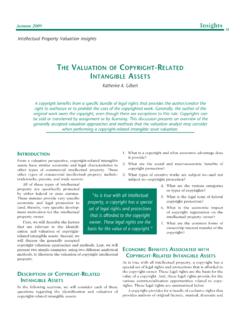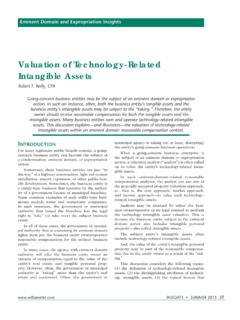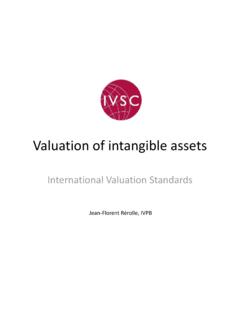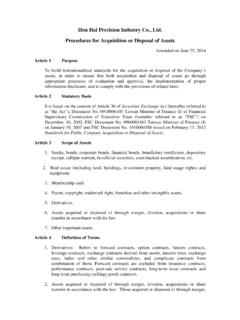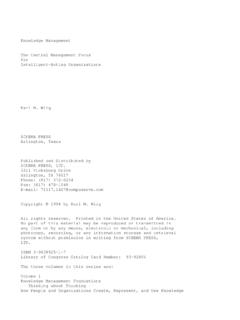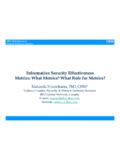Transcription of 017 2 International Valuation Standards - cas.org.cn
1 International Valuation Standards 2 international valuation standards 2 International Valuation StandardsInternational Valuation Standards Council, United KingdomEmail: Web: Cover FP:Layout 1 01/07/2011 13:14 Page 11 King Street, London EC2V 8AU, ontact017017 International Valuation Standards2017 International Valuation Standards CouncilCopyright 2017 International Valuation Standards rights part of this publication may be translated, reprinted or reproduced or utilised in any form either in whole or in part or by any electronic, mechanical or other means, now known or hereafter invented, including photocopying and recording, or in any information storage and retrieval system, without permission in writing from the International Valuation Standards Council.
2 Please address publication and copyright matters to: International Valuation Standards Council, 1 King Street, LONDON EC2V 8AU United Kingdom Email: : 978-0-9931513-0-9 The International Valuation Standards Council, the authors and the publishers do not accept responsibility for loss caused to any person who acts or refrains from acting in reliance on the material in this publication, whether such loss is caused by negligence or and printed by Page Bros, NorwichIntroductioniiiContentsIntroducti on 1 Glossary 3 IVS Framework 6 General StandardsIVS 101 Scope of Work 9 IVS 102 Investigations and Compliance 12 IVS 103 Reporting 14 IVS 104 Bases of Value 16 IVS 105 Valuation Approaches and Methods 29 Asset
3 StandardsIVS 200 Business and Business Interests 49 IVS 210 Intangible Assets 57 IVS 300 Plant and Equipment 74 IVS 400 Real Property Interests 81 IVS 410 Development Property 88 IVS 500 Financial Instruments 99 Index 108 Introduction1 IntroductionThe International Valuation Standards Council (IVSC) is an independent, not-for-profit organisation committed to advancing quality in the Valuation profession. Our primary objective is to build confidence and public trust in Valuation by producing Standards and securing their universal adoption and implementation for the Valuation of assets across the world.
4 We believe that International Valuation Standards (IVS) are a fundamental part of the financial system, along with high levels of professionalism in applying are widely used and relied upon in financial and other markets, whether for inclusion in financial statements, for regulatory compliance or to support secured lending and transactional activity. The International Valuation Standards (IVS) are Standards for undertaking Valuation assignments using generally recognised concepts and principles that promote transparency and consistency in Valuation practice. The IVSC also promotes leading practice approaches for the conduct and competency of professional IVSC Standards Board is the body responsible for setting the IVS.
5 The Board has autonomy in the development of its agenda and approval of its publications. In developing the IVS, the Board: follows established due process in the development of any new standard, including consultation with stakeholders (valuers, users of Valuation services, regulators, Valuation professional organisations, etc) and public exposure of all new Standards or material alterations to existing Standards , liaises with other bodies that have a standard-setting function in the financial markets, conducts outreach activities including round-table discussions with invited constituents and targeted discussions with specific users or user objective of the IVS is to increase the confidence and trust of users of Valuation services by establishing transparent and consistent Valuation practices.
6 A standard will do one or more of the following: identify or develop globally accepted principles and definitions, identify and promulgate considerations for the undertaking of Valuation assignments and the reporting of valuations, identify specific matters that require consideration and methods commonly used for valuing different types of assets or Valuation StandardsIntroduction2 The IVS consist of mandatory requirements that must be followed in order to state that a Valuation was performed in compliance with the IVS. Certain aspects of the Standards do not direct or mandate any particular course of action, but provide fundamental principles and concepts that must be considered in undertaking a Valuation .
7 The IVS are arranged as follows: The IVS FrameworkThis serves as a preamble to the IVS. The IVS Framework consists of general principles for valuers following the IVS regarding objectivity, judgement, competence and acceptable departures from the IVS. IVS General StandardsThese set forth requirements for the conduct of all Valuation assignments including establishing the terms of a Valuation engagement, bases of value, Valuation approaches and methods, and reporting. They are designed to be applicable to valuations of all types of assets and for any Valuation Asset StandardsThe Asset Standards include requirements related to specific types of assets.
8 These requirements must be followed in conjunction with the General Standards when performing a Valuation of a specific asset type. The Asset Standards include certain background information on the characteristics of each asset type that influence value and additional asset-specific requirements on common Valuation approaches and methods is in this Book?This book includes the IVS Framework, the IVS General Standards and the IVS Asset Standards approved by the IVSC Standards Board on 15 December 2016, with an effective date of 1 July 2017. Early adoption of these Standards is Changes to these StandardsThe IVSC Standards Board intends to continuously review the IVS and update or clarify the Standards as needed to meet stakeholder and market needs.
9 The Board has continuing projects that may result in additional Standards being introduced or amendments being made to the Standards in this publication at any time. News on current projects and any impending or approved changes can be found on the IVSC website at GlossaryGlossary3 Glossary10. Overview of This glossary defines certain terms used in the International Valuation Standards . This glossary does not attempt to define basic Valuation , accounting or finance terms, as valuers are assumed to have an understanding of such terms (see definition of valuer ).
10 20. Defined Terms2 0 .1. Asset or Assets To assist in the readability of the Standards and to avoid repetition, the words asset and assets refer generally to items that might be subject to a Valuation engagement. Unless otherwise specified in the standard, these terms can be considered to mean asset, group of assets, liability, group of liabilities, or group of assets and liabilities . Client The word client refers to the person, persons, or entity for whom the Valuation is performed. This may include external clients (ie, when a valuer is engaged by a third-party client) as well as internal clients (ie, valuations performed for an employer).
